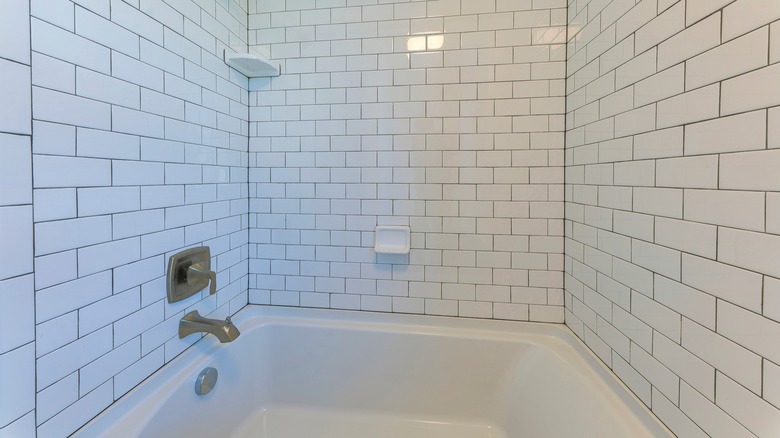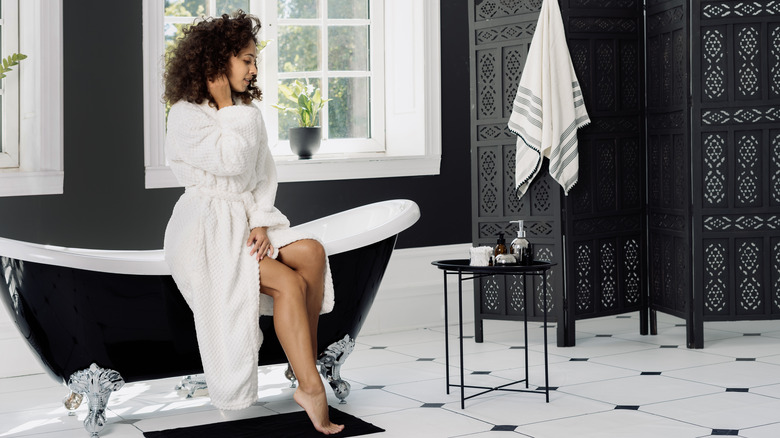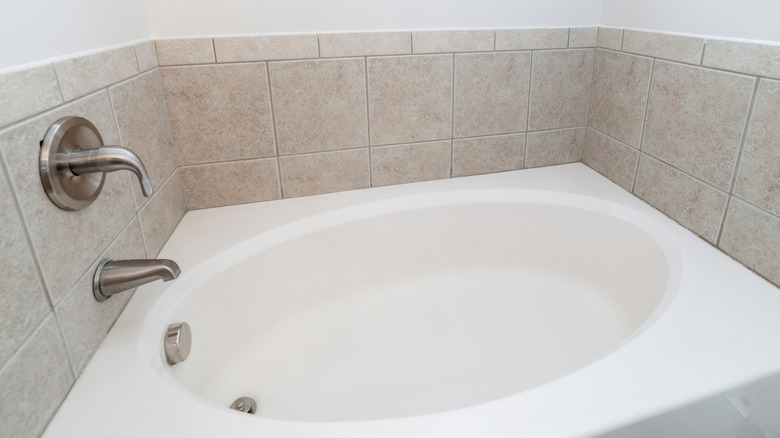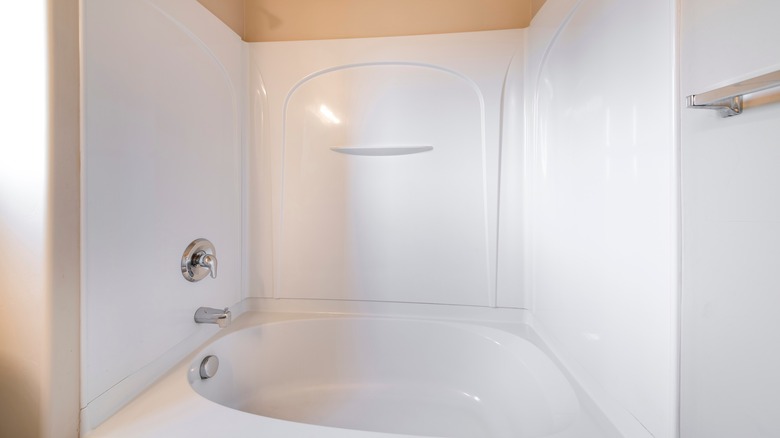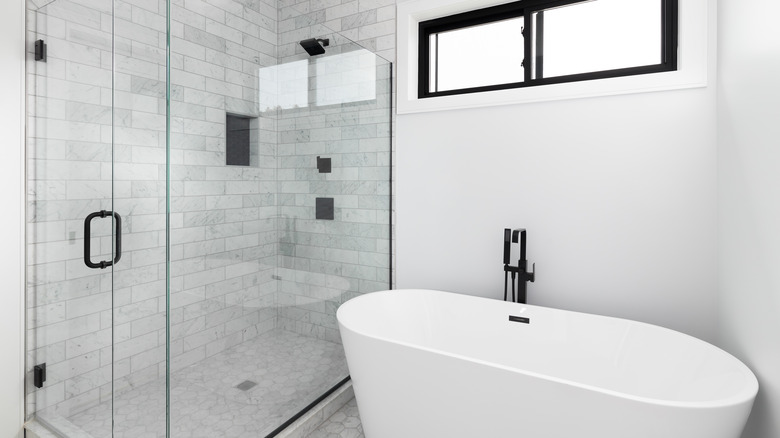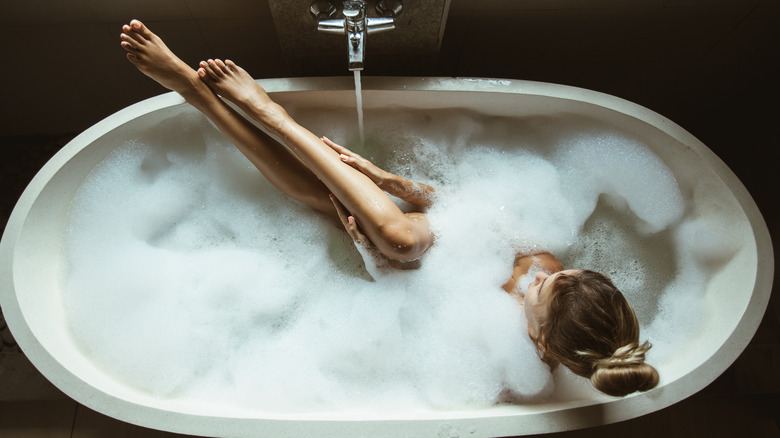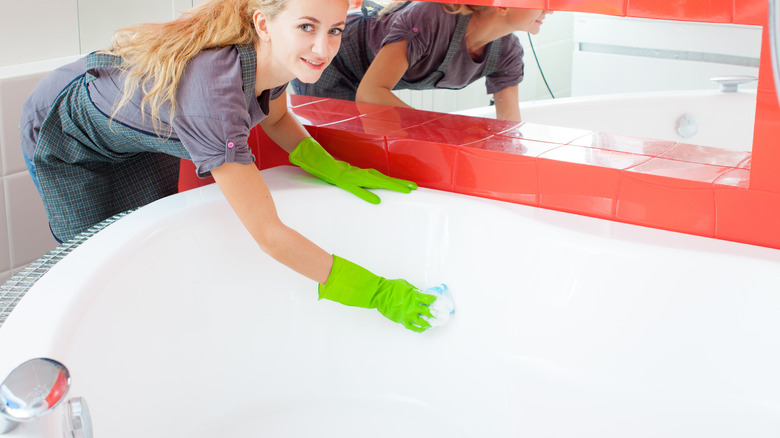Alcove Bathtub Vs. Freestanding Bathtub: What's The Difference?
Here at House Digest, we are passionate about home décor and structural renovations that are not just aesthetic or functional — we also care about increasing your home's resale value. Earlier on, while we spoke about bathroom mistakes that can decrease the resale value of your home, we said that replacing a bathtub with a shower can shrink the overall value of your home. You can also shoot up the resale value of your property if you simply install a bathtub.
In good faith, we want to believe that you have decided to add a bathtub to any of your bathrooms (this would be the most logical thing to do). So, we decided to do a piece on two in-demand bathtub styles in the modern market.
The alcove bathtub is what Badeloft Luxury Bathrooms refers to as a pocket alcove. This is because this type of bathtub is installed into a bathroom extension and is usually encumbered on two or three sides. On the other hand, the freestanding bathtub is the opposite; none of its sides are covered up by walls, writes Kingston Kitchen and Bath. Below, we have done a detailed comparison of both.
How does the composition differ?
The composition of the alcove bathtub hinges on the manner of installation. Some people may argue that it is not a bathtub per se, because it is plugged into a inset or a hole (whichever you call it) in your bathroom. Typically, this inset is in between two adjoining walls and a window, or three adjoining walls, writes Family Handyman. For luxury, most homeowners decide to complete the square and install a shower curtain in the last open space. That will afford more privacy to the area.
On the flip side, the freestanding bathtub is one for the free person, literally! Originating from the original clawfoot design (via Kingston Kitchen and Bath), the freestanding bathtub has all of its sides exposed, unattached to walls. This form comes in quite a few styles as well, including the double slipper, the single slipper, and the soaking tub, among others.
Cost: the freestanding bathtub
Since the freestanding or stand-alone bathtub comes fully ready to install, you may think you get to avoid installation expenses and in the long run, incur a seemingly smaller bill. Well, do not think that way. According to Badeloft Luxury Bathrooms, you should budget at least $1,000 for installation of the standalone bathtub. However, this cost does not in any way include the labor costs; that is a whole different ball game. And, according to Early Experts, you may need to make structural changes to your bathroom to install a freestanding tub without cramping up the entire space.
But, not to worry, this costs only $2,500 on average and $4,500 at an all-time high. If you are looking for quotes for additional costs, Fixr writes that measuring will cost about $650 and plumbing about $550. Got a rough estimate of what your budget should look like? Great, we are happy to help.
Cost: the alcove bathtub
The price for an alcove bathtub significantly depends on how large the bathtub is and which kind of materials were used in making them. You see, the average cost for regular types of alcove bathtubs is $250 to $650, without installation costs. The prices within this range depend on whether or not the bathtub is made out of fiberglass, acrylic, or cast iron, says Modernize.
However, if you are one for luxury, with the jet streams and all, your tub will cost anything between $1,000 to $3,000, writes Badeloft Luxury Bathrooms. Finally, Home Guide writes that the installation labor costs will be between $400 to $2,000. This, as we said earlier, is also dependent on the type of bathtub and the kind of modifications required. However, Fixr gives a much more detailed estimate, stating that for the standard 5-foot acrylic alcove bathtub, you'll be charged $800.
Pros and cons of the alcove bathtub
Okay, before you go ahead and make the alcove bathtub purchase, let us consider the pros and cons and see if it is worth it. The first selling point of the alcove bathtub is the fact that it is not expensive. While there are ostentatious kinds of alcove bathtubs costing about $3,000 or more, there also are cheap ones, so anyone can purchase and replace them easily, as discussed earlier.
Another benefit is the fact that you can always get a bath and a shower combo by simply installing a shower on one of the walls that surround the alcove bathtub. On the flip side, the alcove bathtub can pose a little space constraint. It takes up a lot of room, so if you do not have a really large bathroom, you just may not be able to fit one in there without renovating, writes The Bathtubber.
Pros and cons of the freestanding bathtub
Now, on to the next consideration: the pros and cons of freestanding baths. The first pro to this tub that we would like to point out is the fact that the freestanding bathtub has a much more luxurious look and feel to it than the built-in alcove bath, says Remodelista. We would like to believe that this is because they're reminiscent of historical bathtubs, which were deep, claw-footed, stand-alone bathtubs. Moving on, another pro worth talking about is that it adds style to your bathroom.
On the flip side, the freestanding bathtub loses heat much faster than the built-in version. This is because built-in bathtubs have more insulation, and the Home Efficiency Guide says that poor insulation causes bathtub heat loss. Another con to this bathtub style is its potentially ostentatious nature. Lastly, this bathtub can only be placed in large bathrooms because freestanding bathtubs tend to be the focal point once they are installed.
Durability and maintenance of alcove and freestanding bathtubs
Alright! Before making a decision, you should put the standalone bathtub against the alcove bathtub in terms of maintenance costs, frequency, and of course, the overall durability of the product.
Normally, a good bathtub should last about 30 years, says The Bathtubber. However, this varies and depends largely on the kind of material used to make the bathtub. If your bathtub is made of materials like fiberglass and acrylic, then you should expect a good 10 to 15 years of good use from it. For cast iron, which is what we think is the crème de la crème of top-tier quality, you should expect a full 30-year lifecycle from both alcove and freestanding bathtubs.
Down to the maintenance, what you want to do is to scrub wash the bathtub twice every week. Rinse it out upon each use and flush the jets, seriously, says Aqua Living Factory.
Bathtubs and home value
Okay, sometimes we like to think that there is no point to home remodeling if it is not going to increase the resale or real estate value of your home. There are a lot of points that vary from your comfort to your taste and style (though honestly, the first sentence was just us being extra). But think about it — would you do a $15,000 remodel of your bathroom only to have the resale value drop like an egg, or just stay there, not increasing?
While we leave you to answer that question, we would like to state that The Bathtubber claimed that you will recoup at least 60% of your bathtub investment when selling your home. Dang, that's a lot. Still not sure if you want to get the bathtub? Or keep the current one? Apartment Therapy says to consider mobility issues for young children and adults when deciding to keep a bathtub or not.
When to choose what bathtub over the other
If at this point, you still are unsure about what bathtub to choose, here is our final input: While we understand that this is a huge decision that will affect your lifestyle as well as future security, which you also are aware of, you should read between the lines.
For instance, if you have a family with little children, it is always a hundred times easier to bathe kids inside bathtub than it is to bathe kids in the shower, says Apartment Therapy. Aside from kids, if you are over 50 or someone in your home who uses the bath is over 50, you want to minimize all the risks of slipping and rule out the shower. Lastly, according to Remodelista, you should also consider structural issues like how much weight your floor can withstand. If a lot, then the built-in alcove bathtub is just for you. If not, your best bet will be the freestanding bathtub.

